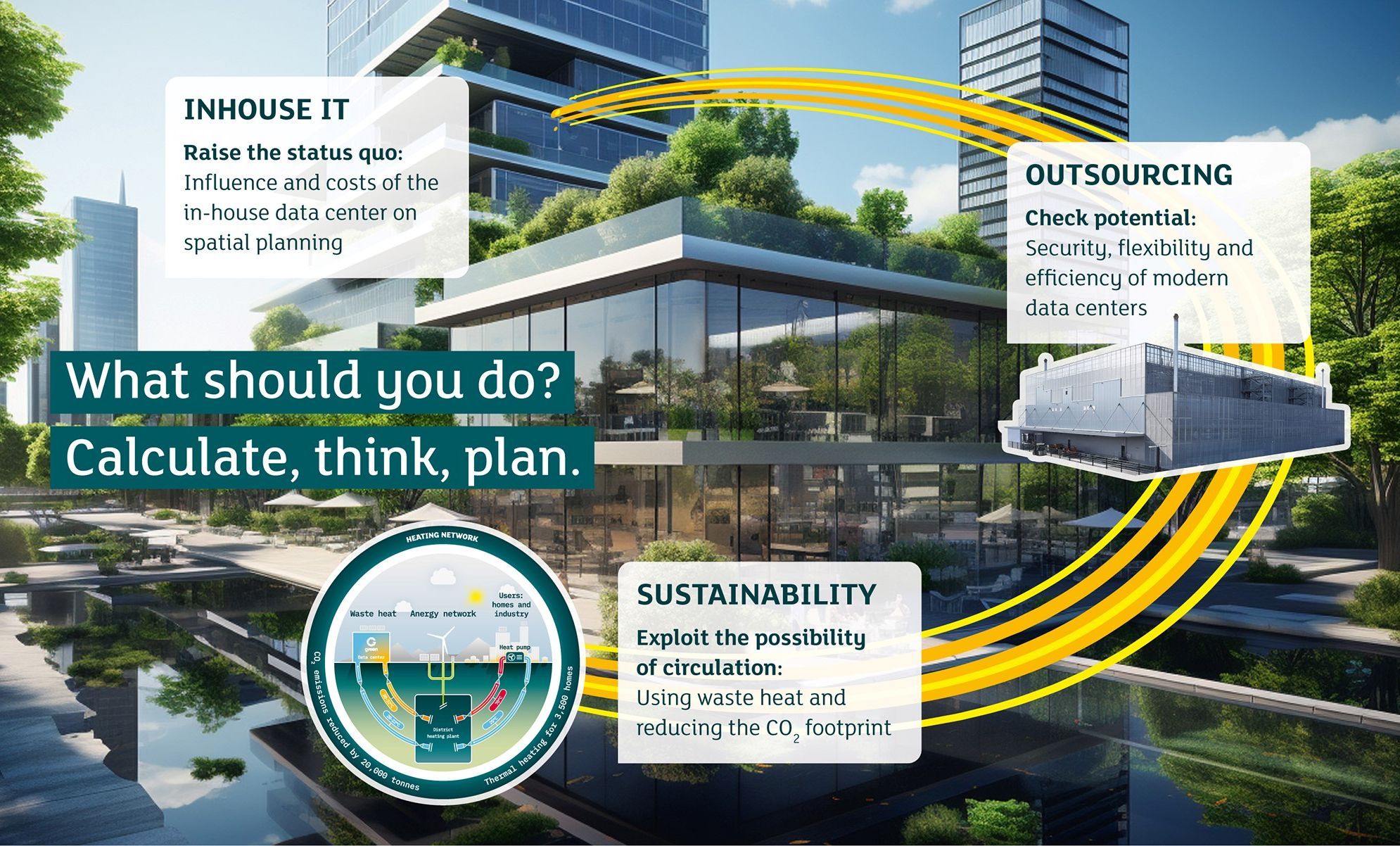![[Translate to Englisch:] [Translate to Englisch:]](/fileadmin/_processed_/7/4/csm_Blog_RealEstate_9c9bd5d8cc.jpg)
Real estate: outsourcing IT and creating space
Companies with their own data centers are well-advised to sit down with their real estate and IT managers to work out where they can optimize their use of space and resources.
This doesn’t just necessarily apply to large companies with IT infrastructures that take up a lot of space – it’s equally as important for those with smaller systems. Essentially, it is relevant for all companies, organizations, and institutions that have their own in-house IT.

In-house data centers: pros become cons, which can also be an opportunity
In-house data centers with their own server systems certainly have their advantages. In most cases, they are highly manageable. You maintain an overview and have everything within easy reach. Data centers of this kind are generally assets that have grown continuously and are valued. They work discreetly and reliably, and have proven their worth over an undisputed period of time. Where this is the case, IT contributes to operational consistency. In many cases, people have even become emotionally attached to their own IT department. They know how things work, and that provides a sense of security.
A false sense of security
However, one thing is becoming increasingly clear: this sense of security has become misleading. And IT is a great example of how benefits can easily become drawbacks. Things that have served IT well for a long time are becoming old, inadequate, and inflexible, and are in need of replacement or an alternative. But why? Because the gigantic volume of data, artificial intelligence, the impact of clouds, and technological developments in general are confronting companies with completely new challenges when it comes to capacity, redundancy, security, availability, and governance, and each of these issues requires experts.
Forty-five percent of companies want their data centers outsourced within five years |
It’s time to act
Plus: the servers in in-house data centers are high-performance units. They also act as heaters, though, whose waste heat usually dissipates. Safeguarding the physical security of the infrastructure and data security is getting more and more complex. IT staff at many companies are also getting older, and new recruits are in short supply and have high expectations. What’s more: the data center itself takes up expensive space, requires a lot of energy, and generates costs non-stop. In addition, new regulations and data privacy laws are constantly being introduced. Stringent security requirements along with high levels of responsibility have become business-critical factors. It’s time to act.
Got questions about data center outsourcing?
We’ll be happy to take the time to talk to you
What needs to be done?
Essentially, what is needed today is to calculate what the real overall costs are for operating your own IT, including space requirements, energy consumption, maintenance, etc., and what the carbon footprint is – as long as this can be calculated and reliable information is available. This could provide a basis for planning optimization activities: for example, determining whether outsourcing IT makes sense, whether repurposing is an option, and how energy-related upgrades could increase value. This applies to both real estate management experts and IT experts alike.
Experts of equal standing
It is also necessary to assess what kind of IT outsourcing is possible, evaluate potential data center providers, and draw up migration and cloud strategies. This is not normally an easy task, so experts from both sides need to work closely together right from the start. This is the only way to ensure the smoothest transition to the new IT future.
Instead of operating an entire server plantation in your in-house data center, you could also fully realign your IT and outsource it, along with everything else, directly to the cloud. But these days, this is usually done in a way that is more “humane”: hybrid, careful, secure. Step by step.
Are you already set up in Switzerland’s most modern data center? |
The future is hybrid and connected
There is a clear trend: the Swiss IT Study, a survey of Swiss IT decision-makers, revealed that around 45 percent of companies want to have their IT outsourced to external data centers within five years. Security, availability, minimal downtime, highly efficient disaster recovery, and, last but not least, far better performance in terms of energy efficiency and sustainability all play key roles in this decision.
Another aspect often underestimated, but which will become increasingly important in the future, is connectivity. Companies with their own data centers are finding it increasingly complex and expensive to design high-availability connections to external IT service providers in a comprehensive, secure, and flexible manner. However, present-day data centers are high-end data hubs: they offer practically unlimited connectivity along with all the options for individual networking requirements with direct access to leading local and global cloud providers.
Connected with over 700 global locations. |
A lot of companies still have their own systems whose useful life is not yet over and therefore benefit from the advantages of both worlds. In most cases, they opt for a customized hybrid solution: an individual combination of internal and external options.
Technological progress is changing the world, including the worlds of IT and real estate
Greenhouse gas emissions in Switzerland must be reduced to zero by 2050. That’s still a quarter of a century off, so you might think there’s still plenty of time. Yet the real picture reveals some startling facts: real estate accounts for over one-third of total CO2 emissions. The average age of buildings, which number around three million, is about 45 years. This means that many buildings were constructed at a time when the focus on resource-saving and environmentally friendly construction methods was still largely absent: a great many buildings face the prospect of undergoing radical change on a varying scale by 2050.
|



![[Translate to Englisch:] [Translate to Englisch:]](/fileadmin/_processed_/f/a/csm_GRE_Animation_Energieeffizienz_Frame_01_6bb96a972c.jpg)